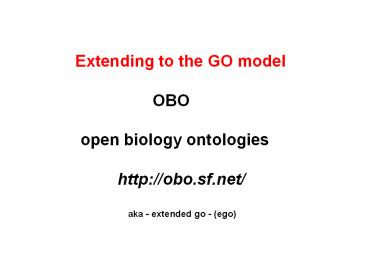Extending to the GO model PowerPoint PPT Presentation
1 / 29
Title: Extending to the GO model
1
Extending to the GO model
OBO open biology ontologies http//
obo.sf.net/ aka
- extended go - (ego)
2
(No Transcript)
3
(No Transcript)
4
obo
obo.sf.net
5
(No Transcript)
6
The aims of SO
- Develop a shared set of terms and concepts to
annotate biological sequences. - Apply these in our separate projects to provide
consistent query capabilities between them. - Provide a software resource to assist in the
application and distribution of SO.
7
What is a pseudogene?
- Human
- Sequence similar to known protein but contains
frameshift(s) and/or stop codons which disrupts
the ORF. - Neisseria
- A gene that is inactive - but may be activated by
translocation (e.g. by gene conversion) to a new
chromosome site. - - note such a gene would be called a cassette
in yeast.
8
Give me all the dicistronic genes
- Define a dicistronic gene in terms of the
cardinality of the transcript to
open-reading-frame relationship and the spatial
arrangement of open-reading frames.
9
- ISA927 relationships
- PARTOF186 relationships
holonym
meronym
10
Classical Extensional Mereology
- The formal properties of parts
- If A is a proper part of B then B is not a part
of A (nothing is a proper part of itself) - If A is a part of B and B is a part of C then A
is a part of C - Because of these rules, we can apply some
functions to parts
11
Extensional Mereology (EM) a formal theory of
parts
EM operation Definition
Overlap (x?y) x and y overlap if they have a part in common.
Disjoint (x?y) x and y are disjoint if they share no parts in common.
Binary Product (x.y) The parts that x and y share in common.
Difference (xy) The largest portion of x which has no part in common with y.
Binary Sum (xy) The set consisting of individuals x and y
12
Exon distribution to transcripts Drosophila
chromosome 4.
Exon part of single transcript 285
Exon in all transcripts 243 (52)
Exon in one transcript 148 (32)
Exon in gt 1 but lt all 74 (16)
13
(No Transcript)
14
Anatomy Ontologies For the
representation of phenotypic and expression
data. Now available for Drosophila, Mus, C.
elegans, Arabidopsis, Ozyra .
15
(No Transcript)
16
(No Transcript)
17
(No Transcript)
18
(No Transcript)
19
(No Transcript)
20
(No Transcript)
21
- The need for a (bio)chemical ontology.
- CAS - commercial expensive.
- LIGAND - no internal structure.
- MESH - semantically weak, very biased
- towards pharmaceutical agents.
- ChEBI - in development at EBI - 1st release
- was June 2004.
22
(No Transcript)
23
(No Transcript)
24
Tissue, cell pathology ontologies. Medical
ontologies - e.g. SNOMED - (a) commercial. (b)
designed not for research, but for
billing.
25
(No Transcript)
26
The next challenge A
syntax and semantics for the description of
phenotypic data.
27
entity
describes
attribute
has
value
28
Thank yous
- Berkeley
- Chris Mungall, John Richter, Brad Marshall
- Insightful biologists
- Midori Harris, David Hill, Bernard de Bono
- My Co-founders
- Suzanna Lewis, Judith Blake, and Mike Cherry
- The GO Editorial Team at the EBI
- Midori Harris, Jane Lomax, Amelia Ireland
Jennifer Clark - SO Karen Eilbeck, Mark Yandel
- And many, many more
29
(No Transcript)

